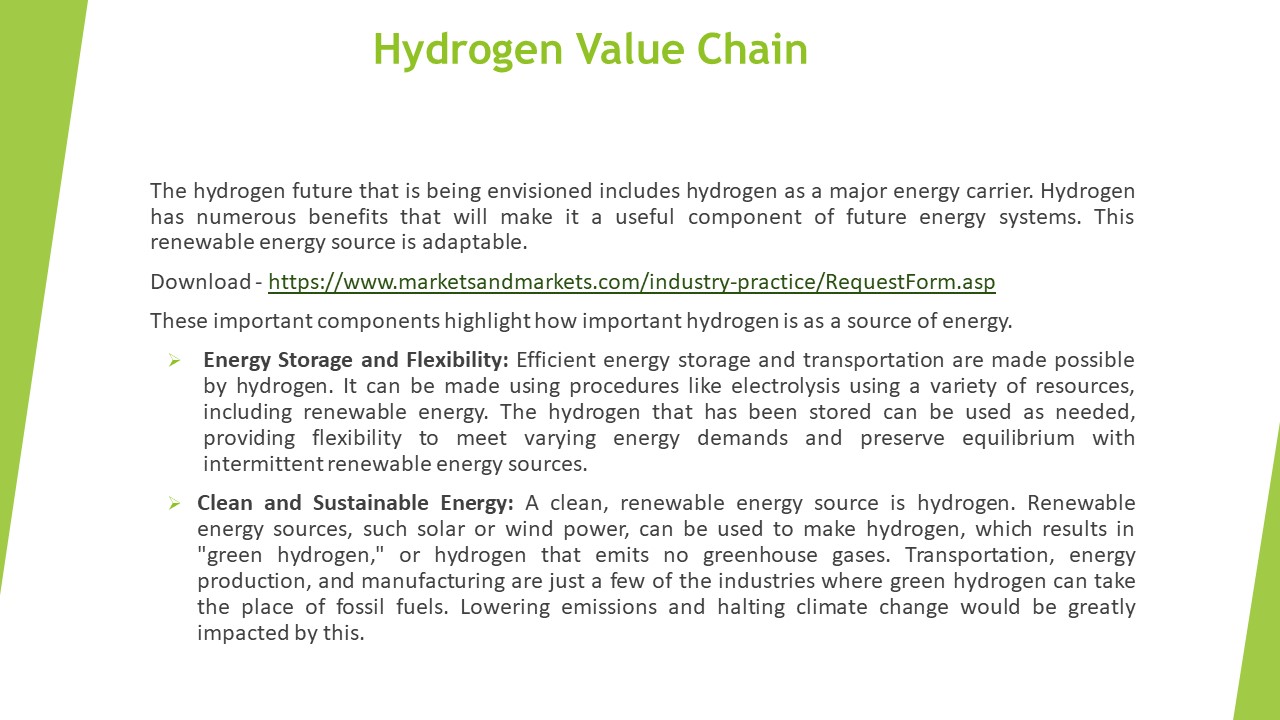Hydrogen Value Chain (1) - PowerPoint PPT Presentation
Title:
Hydrogen Value Chain (1)
Description:
The hydrogen future that is being envisioned includes hydrogen as a major energy carrier. Hydrogen has numerous benefits that will make it a useful component of future energy systems. This renewable energy source is adaptable. – PowerPoint PPT presentation
Number of Views:0
Title: Hydrogen Value Chain (1)
1
Hydrogen Value Chain
- The hydrogen future that is being envisioned
includes hydrogen as a major energy carrier.
Hydrogen has numerous benefits that will make it
a useful component of future energy systems. This
renewable energy source is adaptable. - Download - https//www.marketsandmarkets.com/indus
try-practice/RequestForm.asp - These important components highlight how
important hydrogen is as a source of energy. - Energy Storage and Flexibility Efficient energy
storage and transportation are made possible by
hydrogen. It can be made using procedures like
electrolysis using a variety of resources,
including renewable energy. The hydrogen that has
been stored can be used as needed, providing
flexibility to meet varying energy demands and
preserve equilibrium with intermittent renewable
energy sources. - Clean and Sustainable Energy A clean, renewable
energy source is hydrogen. Renewable energy
sources, such solar or wind power, can be used to
make hydrogen, which results in "green hydrogen,"
or hydrogen that emits no greenhouse gases.
Transportation, energy production, and
manufacturing are just a few of the industries
where green hydrogen can take the place of fossil
fuels. Lowering emissions and halting climate
change would be greatly impacted by this.
2
- Versatility and Sector Integration Hydrogen
exhibits exceptional adaptability in a wide range
of sectors. It is helpful in fuel cells to
generate power for portable, stationary, and
transit needs. In industrial operations, hydrogen
can serve as a suitable alternative to fossil
fuels as a feedstock and heat source. Hydrogen
has the ability to store energy and preserve
system equilibrium, which can aid in the
generation of electricity. - Decarbonization Potential For hydrogen's future,
decarbonization is quite promising. Air pollution
and greenhouse gas emissions could be greatly
decreased when hydrogen takes the place of fossil
fuels in a variety of applications. Achieving
ambitious climate targets is facilitated and the
shift to a low-carbon economy is streamlined. - Technological Advancements and Cost Reduction
Costs are decreasing as hydrogen technologies,
such as electrolysis and fuel cells, continue to
progress and reach economies of scale. It is
anticipated that the price of producing, storing,
and using hydrogen will drop even further as
these technologies progress and become more
economically viable. Later on, using hydrogen as
an energy carrier on a broad scale will be made
easier by this cost reduction as well as
incentives like investments and laws.
3
- Hydrogen Value Chain
- "Hydrogen Value Chain" describes the processes
that go into producing, distributing, and using
hydrogen as fuel. Particularly for industries
like manufacturing, transportation, and power
generation, hydrogen has drawn a lot of attention
as a potential clean and sustainable energy
source. - The hydrogen value chain often consists of the
following steps - Hydrogen Production
- Natural Gas Reforming (Steam Methane Reforming,
SMR) This technique uses natural gas to
chemically generate carbon dioxide and hydrogen. - Electrolysis Electrolysis is used to separate
the oxygen and hydrogen molecules in water. Green
hydrogen can be produced by it using sustainable
energy sources. - Biomass Gasification Biomass can be converted
into hydrogen via a procedure known as
gasification. - Thermochemical Water Splitting Gasification is a
technique that can turn biomass into hydrogen. - Hydrogen Purification and Compression For a
variety of uses, hydrogen frequently needs to be
compressed and filtered after it is created in
order to meet quality and pressure requirements.
4
- Hydrogen Storage Whether it is gaseous, liquid,
or solid, hydrogen is usually kept so it is ready
for use when needed. Chemical hydrides, cryogenic
storage, and high-pressure containers are
examples of common storage techniques. - Hydrogen Transportation Transporting hydrogen
from the sites of production to the final
consumers may be crucial. Cars, ships, or
pipelines can accomplish this, depending on the
required amount and distance. - Hydrogen Distribution Infrastructure for
distribution is needed in order to provide
hydrogen to final consumers. This can entail
building pipes for industrial clients or a
network of hydrogen filling stations for cars. - Hydrogen Utilization Hydrogen has a wide range
of applications, including - Transportation Trucks, buses, and trains that
run on hydrogen as well as fuel cell vehicles
(FCVs). - Industry The creation of metals, chemicals, and
refining are just a few of the industrial
operations that require hydrogen. - Power Generation Using hydrogen, fuel cells can
produce electricity and serve as a backup power
source in addition to a fixed power plant. - Residential and Commercial Heating Both
residential and commercial buildings can benefit
from using hydrogen as a fuel for cooking and
heating
5
- Emissions Reduction Hydrogen has the main
benefit of being able to lower greenhouse gas
emissions this is particularly true when
hydrogen is produced with green hydrogen, or
hydrogen that comes from renewable energy
sources. In order to mitigate the effects of
climate change, fossil fuels are being replaced
in various uses. - Hydrogen Recycling and Reuse Hydrogen is a
sustainable energy source when it is recycled and
reused, according to the circular hydrogen
economy concept. Value chain losses can be
reduced through recycling and hydrogen
collection. - Research and Development To make hydrogen
generation, storage, and use systems more
affordable, safe, and efficient, further research
and development is needed. - The growth of the hydrogen value chain is a
result of continued research, regulations, and
funding intended to increase the long-term use of
hydrogen for renewable energy. The choice of
hydrogen production techniques and the overall
structure of the value chain can be influenced by
a wide range of factors, including local energy
laws, environmental objectives, and resource
availability. - Read More
- https//www.marketsandmarkets.com/industry-practic
e/hydrogen/Hydrogen_Page.asp
Be the first to comment on this presentation.































